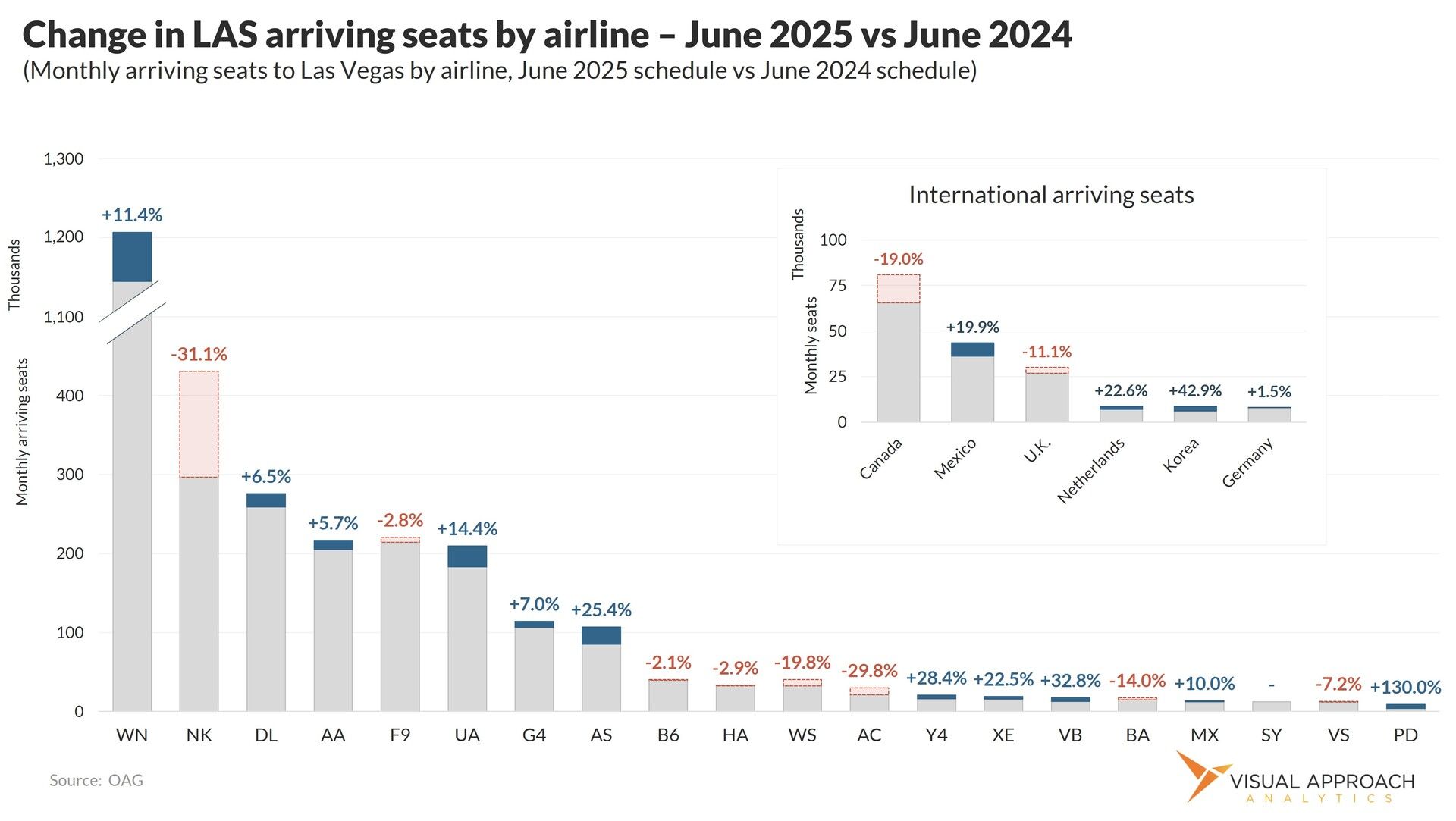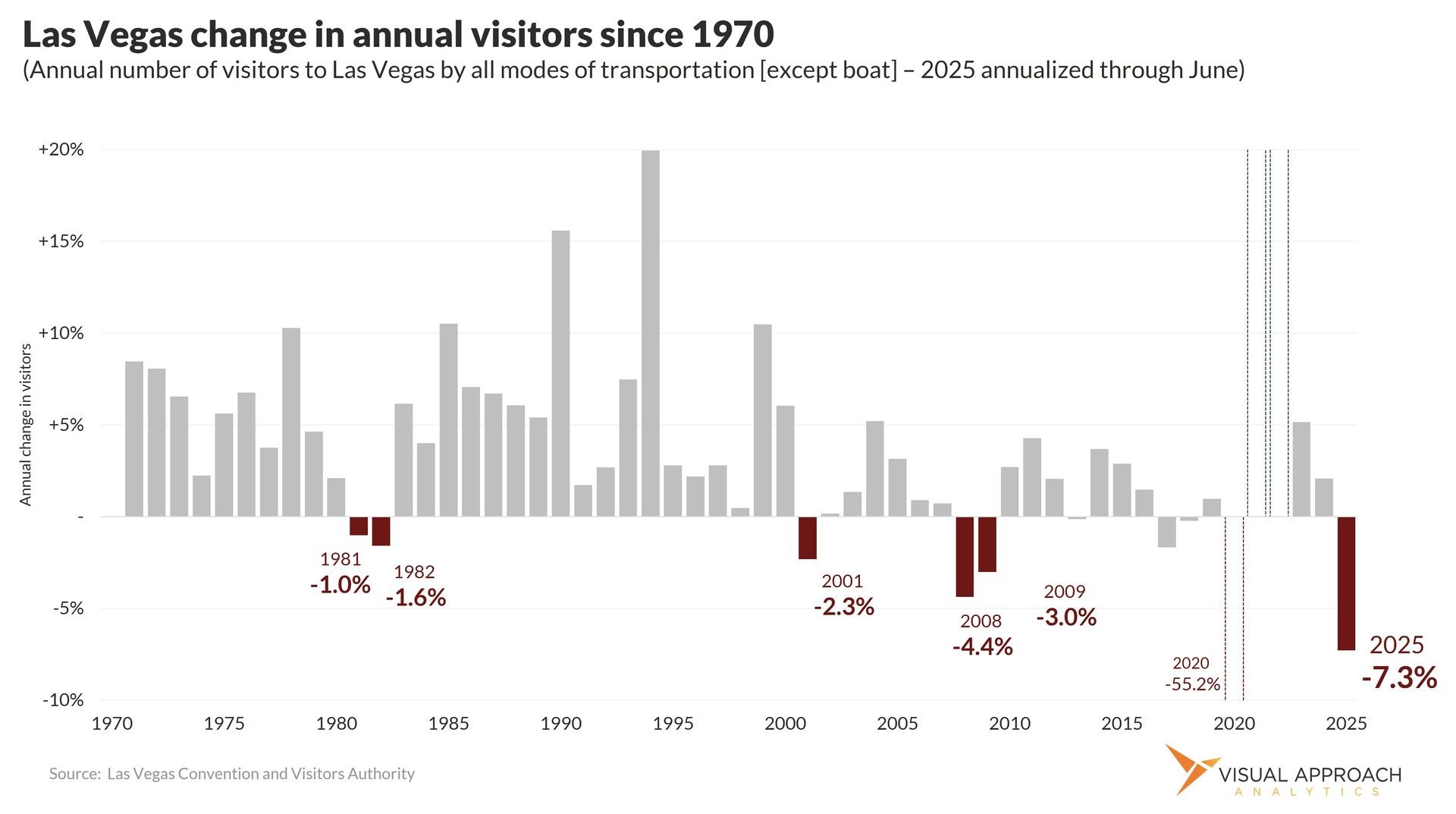- Aviation's Week in Charts
- Posts
- Las Vegas flashes economic warning signs
Las Vegas flashes economic warning signs
What happens in Vegas stays in Vegas - except communicable diseases and economic downturns

Things aren’t looking so hot in Las Vegas.
108 degrees F (42 C) today for those of you in Sin City today, so grab that jacket on your way out the door - because it’s -7 on the economic thermometer.
Las Vegas is cooling. The Las Vegas Convention and Visitors Authority released June numbers, and the trend witnessed during the first part of the year is continuing. Visitors, room rates, and overall revenues are down compared to 2024.
Why does this matter? Las Vegas tends to predict recessions. It’s nothing magical; it’s just the discretionary nature of Las Vegas travel. When the belt gets tightened as travelers consider a slowdown, Vegas is one of the first places that feels the pain. So what’s happening?
Las Vegas is feeling the pain.
June numbers show that overall visitors were down 11% compared to June 2024. Convention attendees were also down 11%. Total enplanements were down 6.3%.

Looking at scheduled flying into Las Vegas in June, capacity was flat. Spirit has dropped a lot of flying, but Southwest, American, Delta, United, and Alaska have picked it up. Canada has taken a large step back, matching the trend we are seeing across the country, with WestJet arriving seats down 20% and Air Canada down 30% (Porter was up 130%, but that’s due more to the service being very new and limited last year).
Canadian arriving seats are down 19% in June 2025 vs June 2024. The UK is down 11%, but other countries have picked up the slack. Mexico is up 20%, while the Netherlands, South Korea, and Germany are all up.
Overall capacity into Las Vegas is largely flat, up .04%, largely due to domestic capacity additions.
So why are visitors down so much? Is this Canada’s fault? Should we really have been blaming Canada all along?
No, it’s not Canada. 2025 is on pace to be down 7.3% compared to 2024 — three million fewer visitors. Canada provides only one million total seats throughout the year, and is still sending 800,000. That’s a red flag, but not the biggest red flag. It’s all visitors, including those who drive. This isn’t a localized phenomenon.
Just how bad is the 7.3% drop in annual visitors (11.3% in June)? Excluding the pandemic, Las Vegas has not seen such a significant drop in visitor numbers since — well, since they started collecting data in 1970.
To answer the question you’re inevitably asking, what about 2008 and 2009? Not great years. 2008 saw overall visitors drop 4.4% and 2009 saw another 3.0% drop.

Put another way, Las Vegas is currently experiencing the entire impact of two years of the Great Financial Crisis… in one year. And June was worse by another half.
But what about overall spending? Things are more expensive now, and Las Vegas is no exception. Could travel be down because rooms in Las Vegas are more expensive?
Unfortunately, no. When looking at just the June numbers, the average daily room rate was down 6.8%. Combined with the drop in visitors, overall hotel room revenues were down 22.3%
Yeah. No kidding.

But there were some bright(ish) spots. Overall traffic in Las Vegas was slightly up, if you can count that as a good thing. This has more to do with local population growth, but it is still a sign of economic activity.
Also, gaming revenues were up. They were up across the county, but also up on the Strip. The fewer visitors to Las Vegas are losing more, so that’s a good thing… I guess?
If Vegas is signalling a downturn and the city is often a leading indicator for recession, does that mean recession is imminent?
Of course not. The shift in Las Vegas travel has been fairly abrupt, showing initial signs in October of last year. But the downward trajectory has been increasing. Las Vegas could pull a rabbit out of a hat during the second half of the year, but that’s not looking likely. In order to do better than the current downward trajectory of 7.3% for the year, the city will need to post positive numbers for the second half of the year. If June is any indication, the deficit is more likely to increase.
But consider that the challenges in Las Vegas are not isolated in their negative view of the U.S. economy. We are seeing warning signs from multiple directions, including housing, jobs, inflation, and corporate earnings.
In economic parlance, that’s called “a sign”.
Or like we used to say in the farmlands of Indiana: “If it walks like a duck and talks like a duck, it’s a duck.”
A chat with Eric Tanner, CCO of Flair Airlines

Does the ULCC model work in North America? New CCO Eric Tanner of Flair doesn't think so. That's why Flair isn't a ULCC.
Our latest podcast welcomes the brand new CCO of Flair Airlines (as of today!) We talk about airlines in North America, from the role of value airlines, to challenges with airport capacity, to the reason Flair survived in the Great White North when so many others failed.
This podcast is a great example of WHY Flair succeeded. Flair Airlines thinks differently about being an airline.
It was dumb luck that we were able to record this so close to Eric's well-deserved promotion to Chief Commercial Officer. This podcast is full of authentic discussion about the airline business, the challenges, and the opportunities that exist. If you want to know how Flair thinks and what makes them successful, this is a must-listen.
Listen to the audio version: https://www.timeonwingpodcast.com/2127612/episodes/17704096-eric-tanner-chief-commercial-officer-flair-airlines
Enjoy the video version:

You should do a chart on…

AI-generated chart that shows… nothing
We like to create valuable charts. But, it’s not easy coming up with new ideas amid the endless hours delivering data-driven edge to our customers. In our quest to provide a valuable weekly newsletter we can keep guessing what you find most valuable, or you could just tell us.
If you have an idea for data visualization, reply to this email and let us know what analysis you’d find most valuable. We’d love to hear from you and will happily name-drop.
ACCESS OUR DATA AND ANALYSIS
We provide bespoke analysis to investors, lessors, and airlines looking for an edge in the market.
Our approach to analysis is data-driven and contrarian, seeking perspectives to lead the market, question consensus, and find emerging trends.
If a whole new approach to analysis could provide value to your organization, let's chat.
If you were forwarded this email, score!
As valuable as it is, don't worry; it's entirely free. If you would like to receive analyses like this regularly, subscribe below.
Then...
You can pay it forward by sending it to your colleagues. They gain valuable insights, and you get credit for finding new ideas!
Win-win!
Contact us
Have a question? Want to showcase your organization in a sponsored analysis? Reach out.
It’s easy. Just reply to this email.
Or, if you prefer the old way of clicking a link, we can help with the hard part: contact